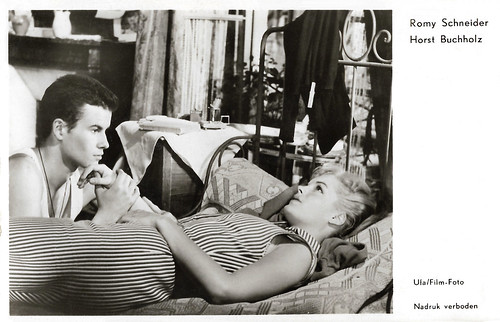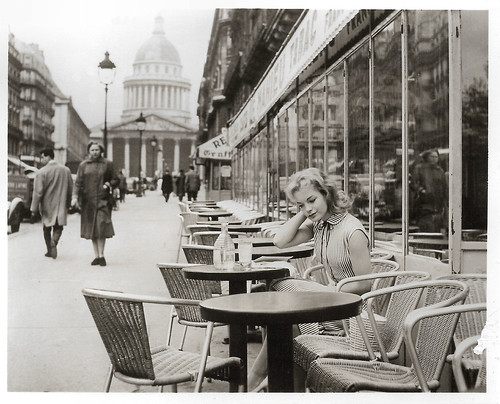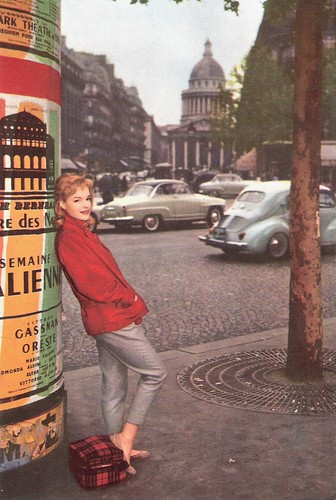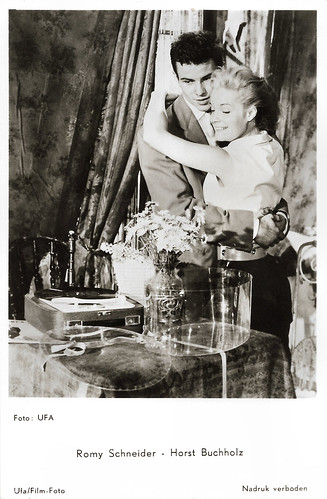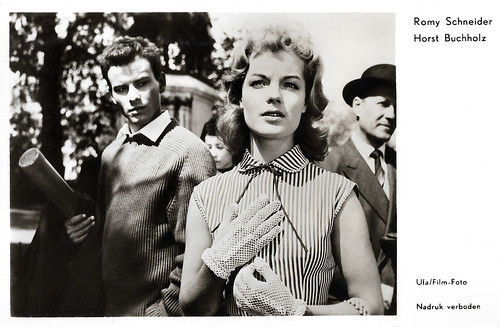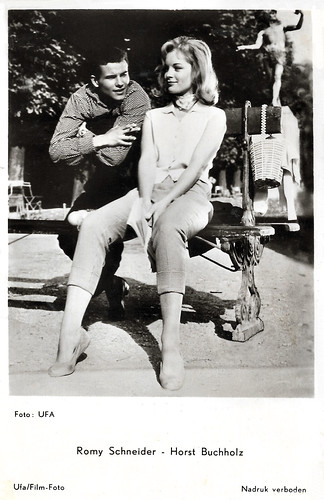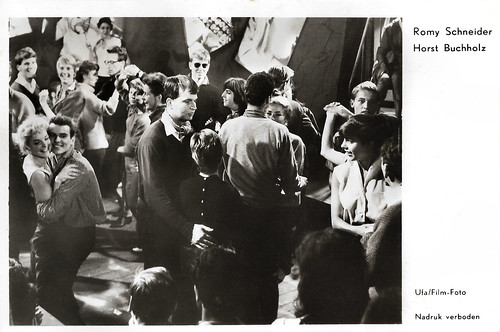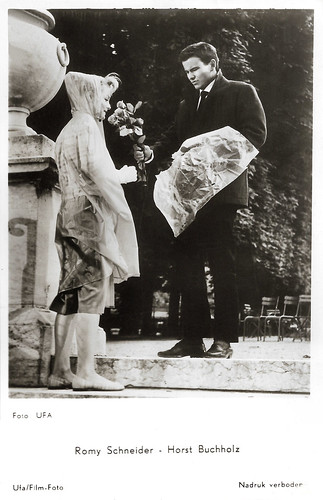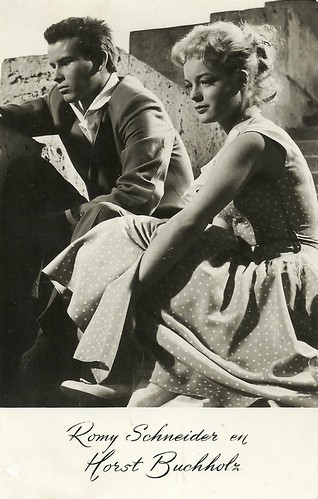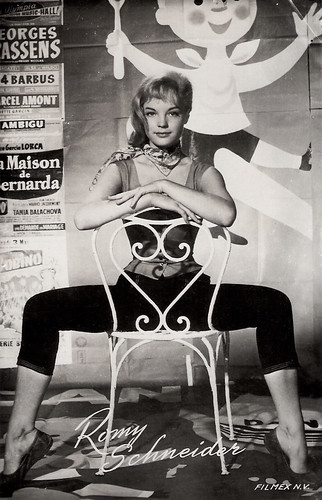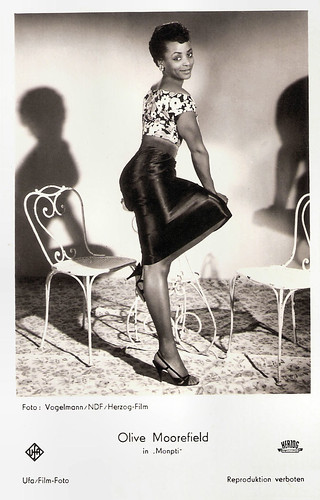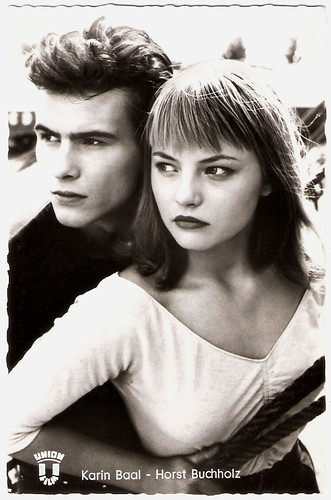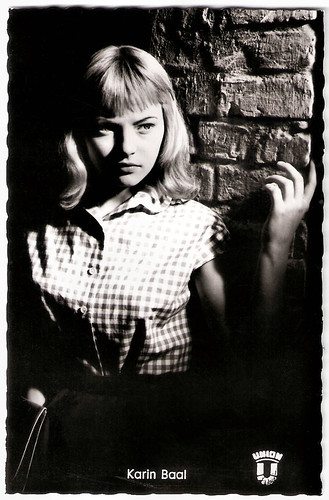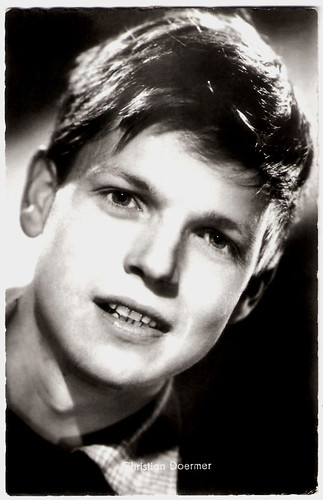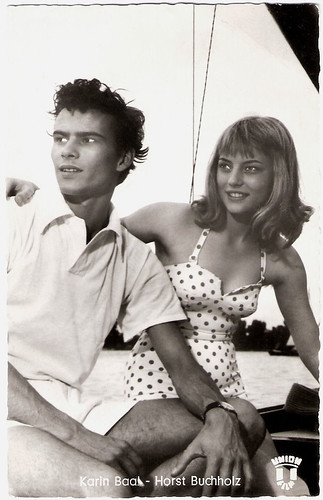
German postcard by Franz-Josef Rüdel, Hamburg-Bergedorf, no. 1858. Photo: Interwest / Union-Film / Haenchen. Publicity still for Die Halbstarken/Teenage Wolfpack (Georg Tressler, 1956).

German postcard by Kolibri-Verlag, Minden Westf., no. 2204. Photo: Interwest / Union-Film. Publicity still for Die Halbstarken/Teenage Wolfpack (Georg Tressler, 1956).
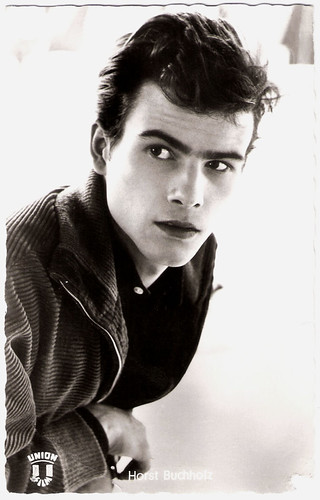
German postcard by Kolibri-Verlag, Minden Westf., no. 2171. Photo: Interwest / Union-Film / Haenchen. Publicity still for Die Halbstarken/Teenage Wolfpack (1956).

German postcard by Kolibri-Verlag, Minden/Westf., no. 2329. Photo: Interwest / Union / Haenchen. Horst Buchholz and Karin Baal in Die Halbstarken/Teenage Wolfpack (1956).

Austrian postcard by Lichtbild-Vertrieb Paula Weizmann, Wien, no. F 7. Photo: Interwest / Union-Film / Haenchen. Horst Buchholz and Karin Baal in Die Halbstarken/Teenage Wolfpack (Georg Tressler, 1956).
Biker-gang leader
Horst Werner Buchholz was born in Berlin, Germany, in 1933. His father was a German shoemaker, while his mother was born to Danish parents. He never knew his biological father. Shortly after his birth, his mother placed him in the care of a foster family. He was given the name Buchholz when, in 1938, his mother married the cobbler Hugo Buchholz and took her son back into her home. They lived in the working-class Berlin district of Prenzlauer Berg. In 1941, her half-sister Heidi was born. She gave her older half-brother the nickname "Hotte", which he kept until his death. During World War II, he was evacuated to Silesia, and at the end of the war, he found himself in a foster home in Czechoslovakia.
Buchholz barely finished his schooling before seeking theatre work, first appearing on stage in 1949. He soon left his childhood home in East Berlin to work in West Berlin. He landed his first stage role at 15 in a theatre version of the German children's classic 'Emil und die Detective' (Emil and the Detectives). In the next years, he established himself in the theatre and on the radio. After some dubbing work, he expanded into a film in 1952 and had a small part in the West German thriller Die Spur führt nach Berlin/All Clues Lead to Berlin (František Čáp, 1952) about a gang of counterfeiters with links to the former Nazi regime.
He had a c0-starring part in Marianne, meine Jugendliebe/Marianne My Teenage Love (Julien Duvivier, 1955) starring Marianne Hold, based on a 1932 novel 'Schmerzliches Arkadien' by Peter von Mendelssohn. The film was released in separate French language and German language versions and Horst appeared only in the German version. Then he won the Best Actor award at Cannes for his lead in Himmel ohne Sterne/Sky Without Stars (Helmut Käutner, 1955) with Erik Schumann and Eva Kotthaus.
His star-making role was the biker-gang leader Freddy in Die Halbstarken/Teenage Wolfpack (Georg Tressler, 1956) with Karin Baal. An English-dubbed version was released in the US as Teenage Wolfpack, with Buchholz billed as Henry Bookholt and promoted as a new James Dean. Hal Erickson at AllMovie: "With the exception of Buchholz, most of the young toughs in the film are nonprofessionals, exuding a raw energy that many 'pros' could not emulate. Most of Die Halbstarken was lensed on location in genuine gang-ridden urban neighbourhoods."
Another major film was Bekenntnisse des Hochstaplers Felix Krull/Confessions of Felix Krull (Kurt Hoffmann, 1957) based on the novel by Thomas Mann. It tells the fantastic story of charming rogue Felix Krull. After he dodges the military draft thanks to his acting abilities, he starts his con man career in a hotel in Paris. Soon he travels the world pretending to be the noble Marquis de Venosta, and his luck with the ladies, namely the eccentric Madame Houpflé and Zouzou, the daughter of his acquaintance Professor Kuckuck, comes in handy. Felix Krull always knows how to impress people, so even when he comes under suspicion of murder, he does not become desperate. The film, and its young star, received international acclaim.

French postcard by St. Anne, Marseille. Photo: Sam Lévin.
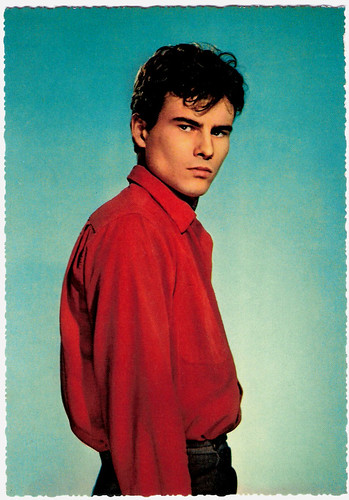
German postcard by Krüger, no. 902/92. Photo: Sam Lévin.

German postcard by Krüger, no. 902/93. Photo: Sam Lévin.
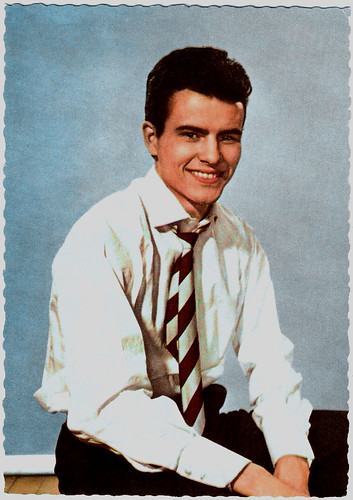
German postcard by Ufa (Universal-Film Aktiengesellschaft), Berlin-Tempelhof, no. CK-147. Retail price: 30 Pfg. Photo: Klaus Collignon / Ufa.

With Myriam Bru. German postcard by Krüger, no. 902/94. Photo: Sam Lévin.
Gandhi's assassin
Horst Buchholz began appearing in foreign films in 1959. He was a villain in the British thriller Tiger Bay (J. Lee Thompson, 1959).
That same year he made his Broadway debut with 'Cherie', which starred Kim Stanley, in 1959. In Hollywood, he followed that with the Western The Magnificent Seven (John Sturges, 1960), a remake in an Old West–style of Akira Kurosawa's Seven Samurai (1954). The ensemble cast includes Yul Brynner, Steve McQueen, Charles Bronson, Robert Vaughn, Brad Dexter, James Coburn, and Horst Buchholz as a group of seven gunfighters and Eli Wallach as their main antagonist. Horst played the role originally portrayed by Toshiro Mifune in the Japanese version. The film was both a critical and commercial success and has been appraised as one of the greatest films of the Western genre.
Then followed the role of Marius in the dramatic romance Fanny (Joshua Logan, 1961) with Leslie Caron, Charles Boyer and Maurice Chevalier. It was based on Marcel Pagnol's play 'Fanny' set in Marseille in the early 1920s. Buchholz also appeared in the Berlin-set madcap comedy One, Two, Three (Billy Wilder, 1961) opposite James Cagney, but then his star started to fade.
As an international star, he played Gandhi's assassin in the British-American neo-noir crime film Nine Hours to Rama (Mark Robson, 1963) and starred opposite Catherine Spaak, Isa Miranda and Bette Davis in the Italian drama La noia/The Empty Canvas (Damiano Damiani, 1963), based on the best-selling novel 'La noia' by Alberto Moravia. He played Marco Polo in La fabuleuse aventure de Marco Polo/Marco the Magnificent (Denys de la Patelliere, 1965) in a cast with Orson Welles, Anthony Quinn and Omar Sharif, but Raoul Levy committed suicide after losing most of his fortune financing this film. Another dud was the Franco-Spanish-Italian international co-production Cervantes (Vincent Sherman, 1967), a highly fictionalised 1967 film biography of the early life of Miguel de Cervantes.
Horst Buchholz's particular moment was over. He took the parts as they came, in films and on television, both in the US and in Europe. He returned to Hollywood lead roles briefly with The Great Waltz (Andrew L. Stone, 1971) playing Johann Strauss which was sadly another failure. More often, he appeared in supporting parts in forgettable comedies, war dramas and such Horror films as The Savage Bees (Bruce Geller, 1976) which follows a swarm of killer bees threatening people during Mardi Gras in New Orleans. He guest starred on episodes of Logan's Run, Fantasy Island, Charlie's Angels, and How the West Was Won.
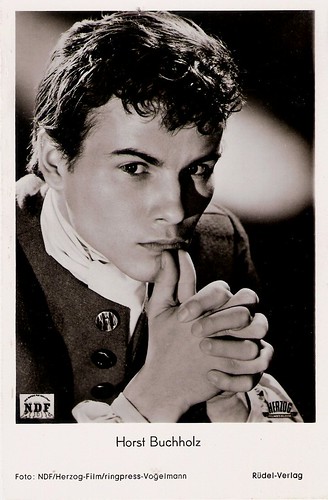
German postcard by Rüdel-Verlag, Hamburg-Bergedorf, no. 1941. Photo: NDF / Herzog-Film/ Ringpress / Vogelmann. Publicity still for Robinson soll nicht sterben/The Legend of Robinson Crusoe (Josef von Báky, 1957).

East-German postcard by Progress Film-Vertrieb, no. 1203. Photo: Ingrid Andree and Horst Buchholz in Bekenntnisse des Hochstaplers Felix Krull/Confessions of Felix Krull (Kurt Hoffmann, 1957).
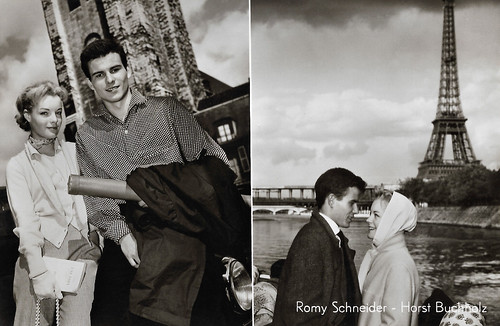
German postcard by Franz Josef Rüdel, Filmpostkartenverlag, Hamburg-Bergedorf, no. 2268. Photo: NDF / Herzog / Vogelmann // NDF / Herzog / Brünjes. Publicity stills for Monpti (Helmut Käutner, 1957) with Romy Schneider and Horst Buchholz.

German postcard by Franz Josef Rüdel, Filmpostkartenverlag Hamburg-Bergedorf, no. M 2482. Photo: Ringpress / Vogelmann / Bavaria. Publicity stills for Auferstehung/Resurrection (Rolf Hansen, 1958).

German postcard by Kolibri-Verlag, Minden Westf., no. 784. Photo: Rank. Publicity still for Tiger Bay (J. Lee Thompson, 1959).

Spanish postcard by Archivo Bermejo, no. 7468. Photo: Warner Bros. Publicity still for Fanny (1962).
Puzzles
In the 1980s, Horst Buchholz mostly appeared in European films. He was the main star of the French-Swiss softcore pornographic film Aphrodite (Robert Fuest, 1982) with Valérie Kaprisky. The film is inspired by the novel 'Aphrodite: mœurs antiques' by Pierre Louÿs and follows a group of visitors who come to an island where they are involved in different sexual liaisons.
He guest starred on the Krimi series Derrick and had a supporting part in the British-American adventure drama Sahara (Andrew V. MacLaglen, 1983) starring Brooke Shields. More interesting was his lead in the Polish-American historical drama I skrzypce przestaly grac/And the Violins Stopped Playing (Alexander Ramati, 1988) and based upon his biographical novel about an actual group of Romani people who were forced to flee from persecution by the Nazi regime at the height of the Porajmos (Romani holocaust), during World War II.
Buchholz also played theatre again in Berlin, for example, the role of the Conférencier in the musical 'Cabaret' at the Theater des Westens in 1979. He then appeared in the judicial drama 'Die zwölf Geschorenen' (Twelve Angry Men) at the Renaissance Theatre in 1984 and in 'Die Geschäfte des Baron Laborde' by Hermann Broch at the Schillertheater in Berlin in 1986.
Also interesting was the fantasy film In Weiter Ferne, so nah!/Faraway, So Close! (Wim Wenders, 1993). It is a sequel to Wenders' film Wings of Desire (1987), set in Berlin after the fall of the wall. Actors Otto Sander, Bruno Ganz and Peter Falk reprise their roles as angels who have become human. The film also stars Buchholz, Nastassja Kinski, Willem Dafoe and Heinz Rühmann, in his last film role. Faraway, So Close! won the Grand Prix du Jury at the 1993 Cannes Film Festival, but enjoyed less critical and commercial success than its predecessor.
Buchholz's last important role was in the Oscar-winning La vita è bella/Life Is Beautiful (Roberto Begnini, 1997). He played the doctor whose obsession with puzzles blinds him to his ability to help Roberto Benigni in the concentration camp. Thanks to his gift for languages, Buchholz was able to dub himself in the foreign releases of the film. The film was an overwhelming critical and commercial success. It received widespread acclaim, with critics praising its story, performances and direction, and the union of drama and comedy, despite some criticisms of using the subject matter for comedic purposes. The film grossed over $230 million worldwide and won the Grand Prix at the 1998 Cannes Film Festival and three Academy Awards, including Best Foreign Language Film.

With Romy Schneider. German postcard by WS-Druck, Wanne-Eickel, no. F 85. Photo: Ringpress / Vogelmann / NDF.
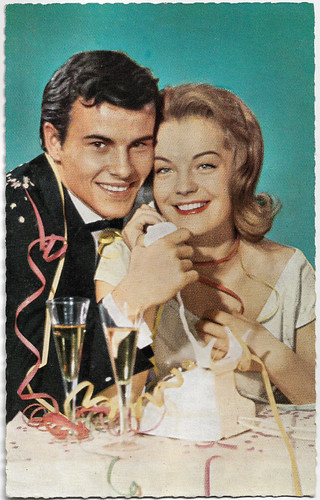
With Romy Schneider. Vintage card.

German postcard by W.S.-Druck, Wanne-Eickel, no. F4. Photo: Ringpress / Vogelmann / NDF.

With Romy Schneider. German postcard by WS-Druck, Wanne-Eickel, no. F 20. Photo: Ringpress / Vogelmann / NDF.

German postcard by Kolibri-Verlag G.m.b.h., Minden (Westf.), no. F 21. Retail price: 25 Pf. Photo: Ringpress / Vogelmann.

German postcard by Kolibri-Verlag G.m.b.h., Minden (Westf.), no. F 22. Retail price: 25 Pfg. Photo: Ringpress / Vogelmann.

German postcard by Ufa (Universal-Film Aktiengesellschaft), Berlin-Tempelhof, no. CK-31. Sent by mail in 1963. Photo: Bavaria Film.

German postcard by Ufa (Universal-Film Aktiengesellschaft), Berlin-Tempelhof, no. CK-112. Retail price: 30 Pfg. Photo: Ringpress / Vogelmann.
Out of the closet
In 2000, Horst Buchholz came out of the closet in the German magazine Bunte as having 'bisexual tendencies', which he had always lived out - albeit in secret: "Yes, I also love men. Ultimately, I'm bisexual. ... I have always lived my life the way I wanted." In the 1950s, the film producer Wenzel Lüdecke was his partner in life.
Buchholz continued making films and television appearances until 2002. His final feature film was the fantasy Detective Lovelorn und die Rache des Pharao/Detective Lovelorn and the revenge of the pharaoh (Thomas Frick, 2002).
In 2003, Horst Buchholz died unexpectedly in intensive care in Berlin of pneumonia while recovering from a broken thighbone. He was 69. Buchholz is buried in the Heerstraße Cemetery, Berlin. Berlin had been the city of his heart and was buried there in honour of that fact.
He was married to French actress Myriam Bru, with whom he had two children, Christoph and Beatrice, who now lives as a Sikh in California under the name Simran Kaur Khalsa. Together with their mother, Buchholz's children realised his wish for a biography in the autumn of 2003, for which he had not found the time. Under the title 'Horst Buchholz - Sein Leben in Bildern' (Horst Buchholz - His Life in Pictures), they brought out an illustrated book with biographical notes that paid tribute to his life's work. His son Christopher Buchholz directed the documentary Horst Buchholz... mein Papa/Horst Buchholz... My Dad (Christoph Buchholz, Sandra Hacker, 2005). The son and daughter of the once-famous film star return to the empty apartment after their father's death and reminisce about his life, with interviews and clips. IMDb calls the film "an intimate and moving portrait of a man who was at once engagingly open to the world and also somewhat reclusive and evasive."
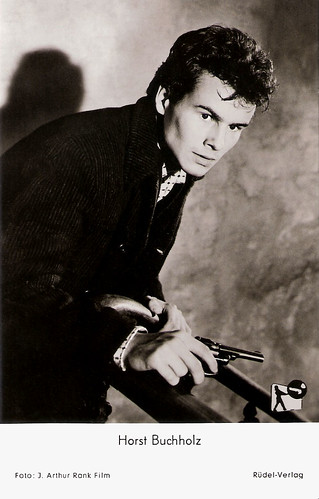
German postcard by Franz Josef Rüdel, Filmpostkartenverlag, Hamburg-Bergedorf, no. 2912. Photo: J. Arthur Rank Film. Publicity still for Tiger Bay (J. Lee Thompson, 1959).

German postcard by Rüdel-Verlag, Hamburg. Photo: Sam Lévin.

German postcard by Rüdel-Verlag, Hamburg. Photo: Constantin. Publicity still for Estambul 65/That Man in Istanbul (Antonio Isasi-Isasmendi, 1965).

German postcard by Rüdel-Verlag, Hamburg, no. 4766. Photo: Vogelmann / Constantin. Publicity still for Cervantes (Vincent Sherman, 1967).
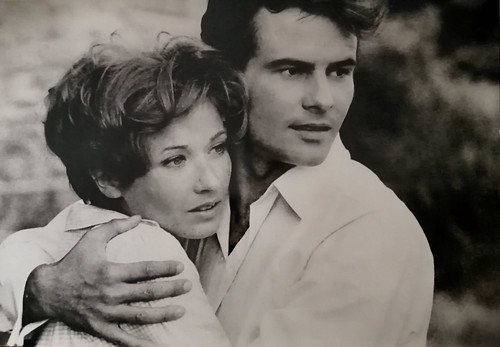
Romanian postcard by Casa Filmului Acin, no. 295. Collection: Alina Deaconu. Marlène Jobert and Horst Buchholz in L'Astragale/Ankle Bone (Guy Casaril, 1969).
Sources: Hal Erickson (AllMovie). Bob Stage (IMDb), Filmportal.de, Wikipedia, Filmreference.com, AllMovie and IMDb.
This post was last updated on 21 August 2023.
